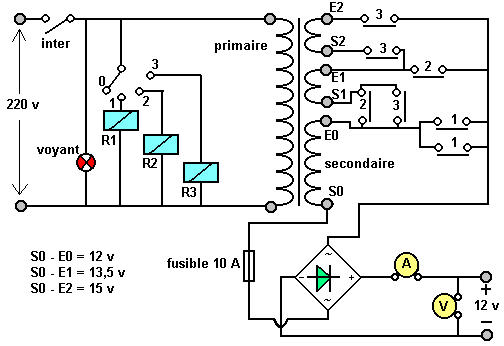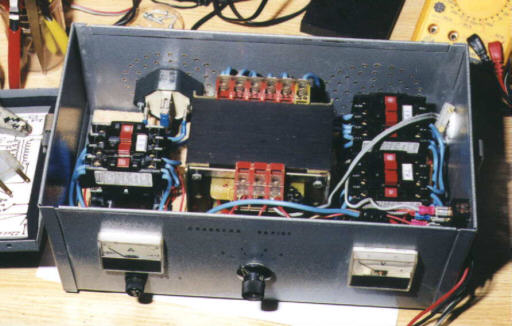A fast charger for battery 12 v

Material :
1 transformer 220/110 volts - 400 volts-amp.
1 ammeter 0 to 6 amp. (45 x 45 mm)
1 voltmeter 0 to 30 volts. (45 x 45 mm)
1 bridge of diodes 25 amp.
1 metal box 310 x 170 x 140 mm.
4 adhesive legs or to screw.
1 fuse holder : 6,3 x 31,5 mm.
1 fuse 10 amp : 6,3 x 31,5 mm.
1 selector 1 tracks with 4 selections.
1 head for the selector (blocking by screw).
3 contactors : 250 v - 12 amp.
1 ligght switch : 220 v - 10 amp.
2 crocodile clips.
1 plug 2 Poles + T - 220 v/10-16 amp.
3 meter cable : 3 x 1,5 mm².
wire : 1 mm² and 2,5 mm².
Advice :
I warn you : this system is a little sophisticated, never the less it can be done by everybody as long as you've got all the materials and a bit of courage.
The basic principles are the same : 1 transformer 220/12 volts and 1 bridge of diodes will be an excellent battery charger.
To make it a fast charger, you need several outputs on the outputs of the transformer. That makes the transformer being a 5 legs sheep which you don't find in shops. So you might as well make it by yourself !
There are 2 types of transformer : one whose plates of the airgap are assembled in quincunx, the other whose plates are soldered in one part.
In those 2 types, you need the transformer whose output is wound outside the frame.
As far as I'm concerned, I salvaged a transformer 220/110 volts of 400 volts-amp I've unwound and rewound with some enamelled copper wire (20/10) : it will be able to output 10 amp. (that will be enough !)
You can also double the whorls if you've only got 10/10 wire, for example.
Make a machine to wind with a hand drill, on which you put the frame of the transformer. The transformer is centered by a drilled wooden cube.
Count how many whorls are unwound, because it'll be useful to know the tensions you need.
If for example, I unwound 110 whorls on my transformer 220/110 v, a simple rule tells me I need 12 whorls to get 12 volts.
There's of course, a formula to know how many whorls according to the airgap surface and the tension you need, but this is too difficult and I prefer my intuition.
The ideal thing would be to find a transformer 220/48 volts.
Here we are, all of that being said, we still have a small trap to avoid : the voltage drop which is caused by the bridge of diodes = square root of 2 or 1,414.
What comes down to saying the alternative 12 v output will only give 10,5 volts in D.C., a loss of about 1,5 volts. Take it into account for your differents couplings.
Very important : when you wind, locate well the inputs (E) and outputs (S) to be prevented from all the confusions in the coupling of the differents reels added.
If you think that the contactors you're using for the coupling are a bit sophisticated, replace them by connecting blocks and a base which can be salvaged on an old electric motor.
Don't forget, for the wiring, count 5 amp a mm². So the power (on the output) will be wired with a 2,5 mm² wire and the control (on the input) with a 1 mm² wire.
Explanations :
The charger being under tension and the selector on position 1 (the most used), the contactor R1 starts and makes output S0 and E0 in the bridge of diodes.
The ammeter, connected in series on the positive one, will have to show about 2 amp, according to the state of the battery.
The volmeter, connected in parallel, will have to show 10,5 volts and the charging time mustn't exceed 3 hours.
The selector on position 2 will active only the contactor R2 and will couple the second reel with the first one : short-circuit E0 and S1 and output 13,5 volts S0 - E1.
The intensity will become 4 amp and the charging time will be 1 hour !
The position 3, that I never use, is to be used with precaution because of the limits of the ammeter. (short-circuit E0 and S1 + short-circuit E1 and S2 = output 15 volts in S0 - E2)





